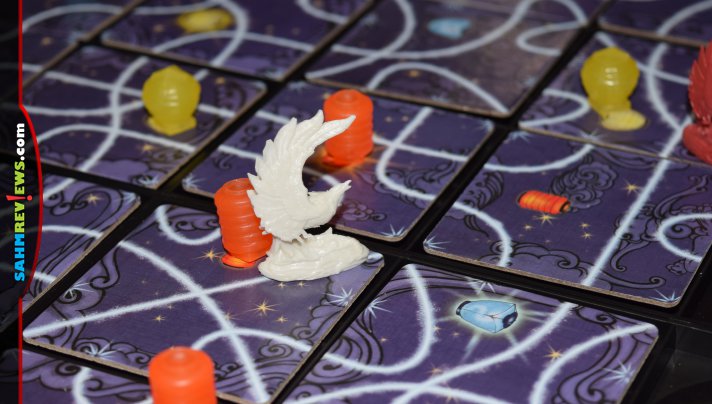Tsuro: Phoenix Rising Tile-Laying Game Overview

When I hear that a game publisher is launching a spin-off of a previously released game, I’m always curious what direction it will go. Are they simply 1) reskinning the game with a new theme, 2) re-releasing the same game to correct mistakes in the original’s gameplay or 3) incorporating the theme and general mechanics into something truly new. Every -opoly game ever is a great example of the first one. The vast array of Ticket to Ride games (like Ticket to Ride London) are an excellent example of the third option. As for #2, I’ll refrain from calling anyone out there. When I heard that Calliope Games was releasing another version of Tsuro, I presumed it would land in the third category. I was right. It’s a nice spin on the original with enough different to make it unique.
Unlike its predecessors, Tsuro: Phoenix Rising doesn’t have a traditional board. Instead, it’s a tray that you assemble before each game. It’s designed to facilitate the flipping of cards that happens throughout the game. The first stage of setup involves preparing the board and placing it in the center of the table. Create a general pool of Star tokens. Separate the center and edge Path tiles and shuffle each stack. The stack of edge pieces goes next to the board with the Phoenix tile on top to hide the details of the cards underneath. Each player takes a life token, a Phoenix pawn and sets the pawn alongside one square on the edge of the board. Once everyone has decided their separate starting locations, randomly lay the 16 center tiles (cloud-frame side up) in the 4×4 grid in the middle. Place Lantern markers on each of the seven Glowing Lantern icons. Each player takes two edge tiles and it’s time to start!
Tsuro: Phoenix Rising takes place over several rounds with players always getting an equal number of turns. When it’s your turn, you’ll create your path, travel then prepare for your next turn. In the first round, you select either side of one of your two beginning tiles and place it in the empty edge space in front of your Phoenix pawn. In additional rounds, whether you place another tile or flip/rotate an existing one is based on whether you’re able to move further on your current path. That will make more sense in a minute, but let’s move on to the next step for clarity first.
Once the tiles has been placed, you need to travel until you reach a dead end, endless loop, run into another pawn or fall of the edge of the board. You must stay on the same pathway, even though it will converge with other lines on your route. While you’re ziplining your way through the path, you’ll need to keep watch for Lantern markers.
If you pass through one without stopping, you immediately place a Star token next to the Lantern marker. Once you’ve finished your movement, you’ll need to address the stars you created along the way. Beginning with the first one that you triggered, remove the Star tokens and place them in front of you. As you remove each, move the Lantern markers to a different place on the board on a tile with the same color/shape lantern that does not already contain a Lantern marker, Star token or your pawn.
You’ll score any stars you collect then you evaluate whether your actions have impacted another player’s route. If you’ve opened up a path for them, they’ll move along their newly extended path and create stars, move lanterns and collect star tokens along the way. Remember how I said there might be a time that you flip/rotate a tile instead of placing a new edge? That happens if your path ends alongside an existing tile where the routes don’t connect with yours. If you begin your turn at one of these dead end locations, you’ll take that tile and rotate it in whichever manner you choose to help you extend your path. Of course, if that tile halted someone else’s turn also, then when you flip it, you may inadvertently help them!
In the event that you run into another player on your route, fall off the board or get into an endless loop, you must remove your pawn from the board. At the beginning of your next turn, you may use your life token to re-enter the game at any edge you choose.
If your pawn stopped because there isn’t a piece to proceed to, you’ll complete the star actions then prepare for your next turn by drawing two tiles from the top of the stack of edge tiles. The end of the game triggers when either one player collects seven or more stars (ends after everyone has had equal turns) or when all other players are eliminated (ends immediately). If it ended due to stars, the winner is the person who has accumulated the most. In the event that everyone was eliminated, the lone remaining player is declared the winner!
Tsuro: Phoenix Rising is a nice alternative to the original Tsuro and Tsuro of the Seas. If you’re ready to add this game to your shelves, ask your local game store for availability, pick up a copy on Amazon or order direct from Calliope Games. Follow Calliope Games on Facebook and Twitter not only to learn about their new titles, but also information about events they’re participating in.
Have you played any versions of Tsuro? Which is your favorite?










No, but it seems marvelous.
Not yet but sounds great
Not Yet – But it looks fun.
I like the original Tsuro game, that’s the one we have!
No, I have not played any versions of this as of yet
I’ve played one of the Tsuros, but not this one yet!
No, I have not played any of these games.
No I have not played any yet .
Haven’t played any versions yet
I never heard of Tsuro games before.
It does sound interesting though
I think I played it several years ago when it had recently come out but I don’t remember a lot about it.
I have never played any versions of Tsuro.
I have not played any version of Tsuro. It sounds like an interesting game, though.
I have not played this game yet.
I’ve never had the pleasure of trying this one….
I have not played this game
I haven’t played any Tsuro games, but I like the aesthetic of the original Tsuro! I’d like to try this tile-laying version as well.
I never played tsuro
Not yet but I’d like to